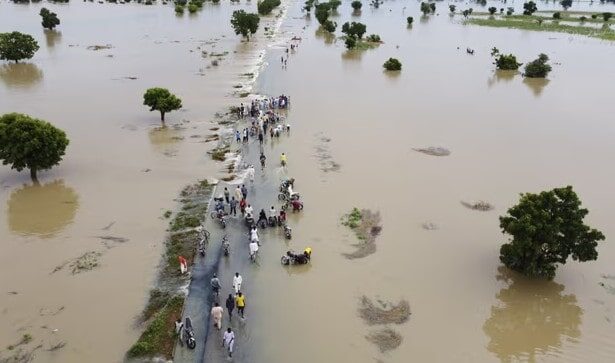The Federal Government has forecasted heavy rainfall over a five-day period that may trigger flooding across 19 states and 76 locations.
The warning, issued on Tuesday by the National Flood Early Warning Systems Centre of the Federal Ministry of Environment, called on stakeholders and residents to take urgent precautionary measures.
This comes as devastating floods struck Ogun and Gombe states on Tuesday, with other states — including Lagos, Plateau, Anambra, and Delta — also affected by the disaster.
According to the centre’s flood prediction obtained by our correspondent, the affected areas are expected to experience rainfall likely to cause flooding from August 5 to August 9, 2025.
The predicted states and locations are Akwa-Ibom (Edor, Eket, Ikom, Oron, Upenekang); Bauchi (Tafawa-Balewa, Azare, Jama’are, Kari, Misau, Jama’a); Ebonyi (Abakaliki, Echara, Ezilo); Cross-River (Ogoja Edor, Obubra); Nasarawa (Keana, Keffi, Wamba); Benue (Agaku, Buruku, Gboko, Igumale, Ito, Katsina-Ala, Ugba, Vande-Ikya); Kaduna (Jaji, Kafancha, Birnin-Gwari, Zaria) and Katsina (Bindawa, Bakori, Daura, Funtua).
Others are Kebbi (Bagudo, Birnin-Kebbi, Bunza, Gwandu, Jega, Kalgo, Kamba, Kangiwa, Shanga, Ribah, Sakaba, Saminaka, Yelwa, Gauri-Banza); Kano (Bebeji, Gezawa, Gwarzo, Kano, Karaye, Tundun-wada, Wudil, Kunchi); Niger (Kontagora, Rijau, Ringim); Plateau (Mangu); Taraba (Donga, Takum); Jigawa (Diginsa, Gumel, Dutse, Gwaram, Hadejia, Miga); Yobe (Machina, Potiskum); Zamfara (Anka); Sokoto (Sokoto, Wamakko); Borno (Biu); and Gombe (Bajoga).
Flooding in Nigeria has become a yearly occurrence that claims lives and destroys many properties. Last year, 31 states were reportedly affected by flooding, causing hundreds of deaths, injuring thousands of others and affecting 1.2 million.
On September 10, 2024 the Alau Dam collapsed, causing floods in Borno State, killing at least 150 people, displacing 419,000 others and causing the community to submerge 70 per cent.
The country has experienced a series of flooding events that caused property damage, fatalities, injuries and displacement this year. The deadliest flood so far this year was in May that reportedly killed at least 200 people with thousands displaced in Mokwa, Niger State.
The floods, triggered by intense rainfall and exacerbated by a dam collapse, caused widespread destruction and severely impacted the community’s access to essential services.
While Mokwa was the most severely affected area, other parts of Nigeria also experienced flooding in 2025. The flooding affected multiple states, including Rivers State – where torrential rains caused floods and landslides that buried homes and swept people away in the city of Okrika, killing at least 25 people – and put millions of people at risk.
In April, at least 13 people were killed in Kwara State and Mokwa, including three people on a canoe that capsized on a flooded river, and rice fields were destroyed after flooding triggered by the routine water release from the Jebba Hydroelectric Power Station dam affected 30 communities.
Recently, the National Economic Council approved the release of intervention funds to support nationwide flood mitigation and response efforts.
NEC approved the disbursements of N3bn each to the 36 states and the Federal Capital Territory; N1.5bn to the Federal Ministry of Budget and National Planning; N1.5bn to the Federal Ministry of Environment; N1.5bn to the Federal Ministry of Water Resources and Sanitation; and N10bn to the National Emergency Management Agency.
In a dashboard released last Friday by NEMA, it showed that no fewer than 165 persons have died, 82 missing and 119,791 persons have been affected by this year’s flooding.
The agency also stated that 138 persons sustained various degrees of injuries, 43,936 displaced, 8,594 houses affected and 8,278 farmlands destroyed across 43 Local Government Areas in 19 States.
According to the agency, children and women were mostly affected.

Address: No 5 Ejembi Eko Street, New GRA, Makurdi, Benue State, Nigeria






